
|   |

|   |
Resonances of nature - Padma Jayaraj e-mail: padmajayaraj@gmail.com Photos courtesy the artist May 11, 2013 Sadaanandan, the mural artist from Kerala has traversed miles and miles down the meandering lanes of the world of art traditions since I have seen his solo show in the art gallery of Kerala Lalitha Kala Akademi, Thrissur, a decade ago. The mural art of Kerala has its own story to tell. Celebrated as temple art, it was closed to the lower sections of society. During the British rule, lack of patronage affected a decline. Consequently, when the Guruvayoor Devaswam wanted to renovate its murals after a fire in the early seventies, they could find only a lone, aged artist, Mammiyur Krishnan Kutty Nair. The temple murals were renovated under his guidance. Then the Guruvayoor Devaswam started an institute for mural painting. Sadaanandan belongs to the foremost artists of this premier institute. Mural painting today, represents a particular style, although it originated as wall painting. The background, medium, stylisation, and themes have changed beyond recognition from its original. Sadaanandan, like many of the later stalwarts, carried on his guru’s legacy. As per his advice, the artist started travelling, visiting monuments in India, meeting masters and philosophers in Indian art traditions. He travelled all over Kerala studying its murals in its pure, original form. He did his Masters in Fine Arts from Karnataka University. One of the foremost artists to experiment on canvass, Sadaanandan’s oeuvre shows a shift both in theme and form. Decorative in style, religious in theme, he enjoyed popular appreciation initially. The present display, his eleventh solo-show in Jahangir Art Gallery, Mumbai from 17th to 23rd April, shows a marked ascendance in his artistic perceptions. The Indian cultural milieu forms the warp and weft of his web as the artist weaves colourful patterns with Indian thoughts and receptivity. Of course the hues and nuances are new. 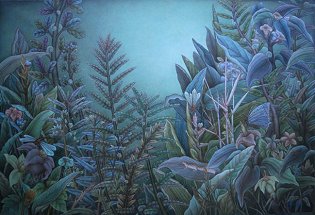 Ayur plants 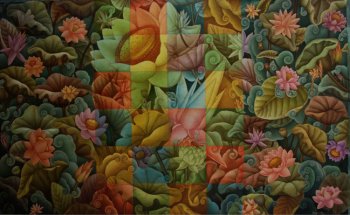 Lotus series 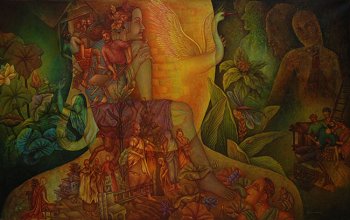 Jataka tales 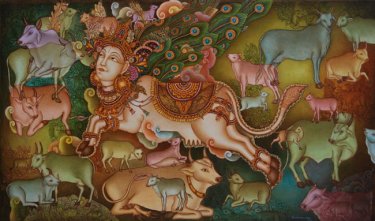 Kamadhenu Ayur Plants (the life-sustaining plants) series in wild setting is pleasing to the eye, which has environmental concerns for its philosophy. The stylized floral patterns of the authentic mural depiction are enhanced by the use of sober and pastel colours and misty morning light in the background. The Lotus series is true to the mural traditions in execution, in different shades unknown to the old mural world. The empirical lotus flower in India’s artistic traditions is enchanting with spiritual and aesthetic connotations. The winged creatures co-habit this world sharing a symbiosis in the divine chain. You almost hear the flutter of their iridescent wings, hear the music in their hum. One step ahead is the Tree of Life series that includes the Buddhist concept of nature as an abode for all living creatures. Now we enter the realm of the myths. The Jataka tales series reveal the Buddhist lore that has been part of the accumulated sediment over many millennia in the layers that form Indian sensibility. Then we come to the Hindu mythology- the veritable world of the animal, the human and the divine all mixed together in various degrees of the fantastical. If Kamadhenu evokes the mythical, Gomata echoes social and cultural evolution. Ganesha is depicted as the scribe of Vyasa who dictated the Mahabharatha. Hanuman is not the popular Rama bhakta. According to the artist, Upanishads speak of Hanuman as a scholar. Krishna is depicted embodying the spirit of Bhagavata. And Radha is Nature herself 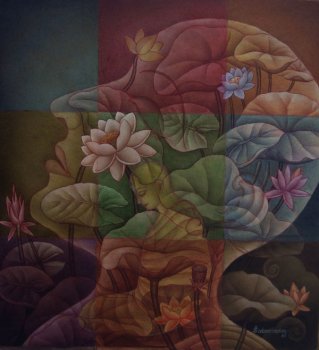 Yoga vision 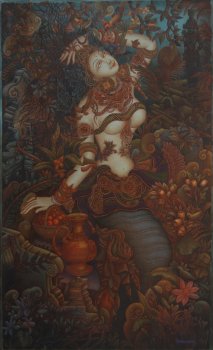 Radha What is special about Sadaanandan’s art is its evocative quality: nature redolent with myths. Without defining theoretical tenets, culture and concept are suggested. Elements of the narrative and the visual coalesce to give new dimensions. Large canvass that holds your attention, the colours that create a surreal sense, and the mixed media used to paint, are the salient features of Sadaanandan’s work. Classical in concept, contemporary in orientation, experimental in depiction, the artist moves on. And it is for you to enjoy its aesthetics. Padma Jayaraj is a freelance writer on the arts and travel. She is a regular contributor to www.narthaki.com |